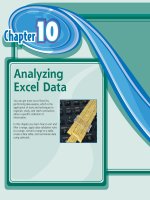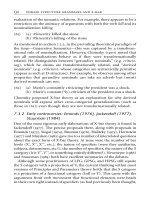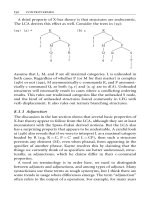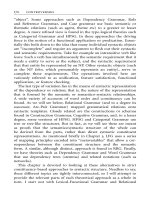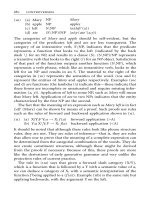Tài liệu Constituent Structure - Part 18 pptx
Bạn đang xem bản rút gọn của tài liệu. Xem và tải ngay bản đầy đủ của tài liệu tại đây (134.07 KB, 10 trang )
A third property of X-bar theory is that structures are endocentric.
The LCA derives this eVect as well. Consider the trees in (29):
()
(a)
*
K (b)
*
K
JL JL
j
MP
j
MP
QR Q
RS
qr q
r T
t
Assume that L, M, and P are all maximal categories. L is unheaded in
both cases. Regardless of whether P (or M for that matter) is complex
(29b) or not (29a), M asymmetrically c-commands R, and P asymmet-
rically c-command Q, so both hq, ri and hr, qi are in d(A). Unheaded
structures will necessarily result in cases where a conXicting ordering
results. This rules out traditional categories like the unheaded S node,
and the kind of unheaded structures found commonly in LFG with
verb displacement. It also rules out ternary branching structures.
8.3.3 Adjunction
The discussion in the last section shows that several basic properties of
X-bar theory appear to follow from the LCA, although they are at least
inconsistent with the Speas–Fukui derived notions. But the LCA also
has a surprising property that appears to be undesirable. A careful look
at (29b) also reveals that if we were to interpret L as a maximal category
headed by R (e.g. R ¼ C, P ¼ C’ and L ¼ CP), then such a structure
prevents any element (M), even when phrasal, from appearing in the
speciWer of another phrase. Kayne resolves this by claiming that the
things we currently think of as speciWers are better understood, struc-
turally, as adjunctions, which he claims diVer in their c-command
properties.
A word on terminology is in order here. we need to distinguish
between adjuncts and adjunctions, and among types of adjunct. Many
syntacticians use these terms as rough synonyms, but I think there are
some trends in usage where diVerences emerge. The term ‘‘adjunction’’
often refers to the output of a operation. For example, for many years
150 controversies
Chomskyan grammarians have treated topicalization or heavy NP
shifts as a type of adjunction. Conversely, ‘‘adjunct’’ seems to be
reserved for those situations where base generation is in eVect. Ad-
junct, itself, has several distinct usages (which sometimes converge on
the same set of syntactic objects). It has a semantic/functional usage,
referring to some category that is not required by the predicate. It also
has the X-bar theoretic meaning, referring to the sister of X’ and
daughter of X’. To make matters even more confusing, some scholars
typically treat adjuncts as adjunctions. Let us distinguish the terms the
following way: We will reserve the term ‘‘adjunct’’ to its X-bar theoretic
usage; that is, a modiWer that is attached between a head, its comple-
ment, and the XP projected from that head. We’ll use the term
‘‘adjunction’’ to refer to the particular structural conWguration case
of so-called Chomsky Adjunction.
Chomsky Adjunction involves taking an extant phrasal category as
the landing site for a movement, splitting it into two parts called
‘‘segments’’. Neither segment alone counts as a category. The category
is the two segments taken together. This can be seen in the abstract tree
in (30). Each of the XPs is taken as a segment of the larger XP category.
Individually the segments do not count as categories for the purposes
of calculating c-command in binding and scope interactions (May
1985).
()XP segment
XP category
12
YP
i
XP segment
WP …t
i
…
With this structure in place we can explain how speciWers and adjuncts
are allowed in Kayne’s system. First we require an extra stipulation on
c-command as given in (31) and (32). (These deWnitions are in the
spirit of May’s 1985 proposal):
(31) A c-commands B iV
(a) A and B are categories;
(b) A excludes B;
(c) every category that dominates A dominates B.
12 Notice again that this kind of structure is impossible in a Speas-style analysis, as there
is no primitive XP to be split into two segments. Only the topmost element would count as
an XP. For a critical look at Chomsky Adjunction, see Chametzky (1994).
set-theoretic constituency 151
(32) X excludes Y iV no segment of X dominates Y.
The idea here is that segments do not c-command elements which are
dominated by a distinct segment of the category they belong to. So
consider the tree in (33), where M (a phrasal level category is in an
adjunction relation to P. M is dominated by the higher segment of P,
but not by the lower one. The lower segment of P does not c-command
M (nor its daughter Q), because the category P does not exclude M.
()
P (=XP)
M(=MP)
P(=XP)
Q
RS
q
r
T
t
This in turn means that P does not c-command Q. Therefore M
asymmetrically c-commands R and P does not asymmetrically c-com-
mand Q, so the pair hq, ri is in d(A), but the pair hr, qi is not. So in
order to escape the requirements of the LCA, speciWers are Chomsky-
Adjunction structures.
A similar fact explains part of the head-movement constraint (Travis
1984) (Heads move into other heads cyclically.) In particular, it rules
out the adjunction of a phrase to a head. Consider the abstract tree in
(34) where U is a phrase adjoined to the head M.
()L
MP
U(=UP) M R S
W mrT
wt
Because M does not exclude U, M is irrelevant for calculating the c-com-
mand relations of U. This means that, somewhat counter-intuitively,
U asymmetrically c-commands R. More intuitively, P also asymmetrically
c-commandsW. Thismeans that thepairs hw, ri, hw, ti and hr, wi, ht, wi are
152 controversies
in d(A).13 So a phrase adjoined to a head is unlinearizable. By contast,
consider the tree in (35), where a head is adjoined to a head:
()L
MP
UMRS
umrT
t
In this tree, U (surprisingly) c-commands P and Pc-commandsU,sothe
relation is symmetric. This means that the Antisymmetry relations are:
(36) A ¼ {hU, Mi, hU, Ri, hU, Si, hU, Ti, hM, Ri, hM, Ti, hR, Si,hR, Ti}
d(A) ¼ {hu, mi, hu, ri, hu, ti, hm, ri, hm, ti, hr, ti}
Neither hP, U i nor hU, Pi is in A, so it is not ruled out the same way as
(34); there is no contradictory ordering between u and r or t.
Kayne’s Antisymmetric approach also predicts that neither multiple
adjunctions nor multiple speciWers will exist (cf. Ura 1994). In the
following tree M and L should be taken either as multiple speciWers
or multiple adjunctions:
()U
P
LP
KM P
k QR S
qr T
t
Because the node not excluding all of L, M, R is U, it follows that
M asymmetrically c-commands K, and L asymmetrically c-commands Q.
13 A ¼ {hU, Mi, hU, Ri, hU, Si, hU, Ti, hM, Ri, hM, Si, hM, Ti, hR, Ti, hP, Wi},
d(A) ¼fhw, mi, hw, ri, hw, ti, hm, ri, hm, ti, hr, ti, hr, wi, ht, wig
set-theoretic constituency 153
Therefore both hk, qi and hq, ki are in d(A)—resulting in a violation of
the LCA.
One of the most intriguing predictions of the LCA is the claim that
underlyingly all sentences in all languages must be ordered as SVO (or
more precisely speciWer–head–object).
()P
MP
QR S
qr T
t
The speciWer of any tree (M) asymmetrically c-commands the head (R)
and R asymmetrically c-commands the head of the complement (T).
This means that the image of A in any such arbitrary tree will include
hq, ri,andhr, ti and not their inverses.14 This results in universal SVO
order. This of course has been controversial among linguists working on
languages with a non-SVO order! The claim of Antisymmetry is that any
non-SVO order must be a derived order. Charges of anglocentrism aside,
this claim has generated an important research program involving subtle
word-order variations that are analyzed through massive movement of
material leftwards in the tree. See, for example, work on Hungarian,
German, and Dutch word orders in Koopman and Szabolci (2000).
8.4 Bare Phrase Structure
Both Speas’s relativized phrase structure system and Kayne’s Antisym-
metric system attempt to derive the properties of X-bar theory and
phrase structure in general. But they are largely mutually incompatible.
14 Lasnik, Uriagereka, and Boeckx (2005) point out that this aspect of the LCA does
seem to make at least one wrong prediction. Observe that the ordering of prehead
modiWers and post-head modiWers is a mirror image when it comes to scope relations.
(i) The theory of syntax which is suspect ¼ the suspect syntactic theory. (6¼ the syntactic
suspect theory)
If we take scope to be an eVect of c-command, then we accept that the right-most post-
head modiWer must c-command elements to its left in violation of the LCA. One can
construct a derivation that gets around this by doing massive movements, but this does
seem very suspect.
154 controversies


